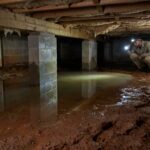Essential Guide to Foundation Repair: Protecting Your Home’s Structural Integrity
When you think of home repairs, images of paint splatters and garden gnomes might come to mind. But lurking beneath the surface of your charming abode is one of its most critical components: the foundation. Like a superhero in disguise, your foundation supports everything above it—your walls, your floors, and even that collection of decorative spoons you inherited from Aunt Edna. This essential guide aims to help you navigate the sometimes murky waters of foundation repair to ensure that your home remains standing tall and proud for years to come.
Understanding the Importance of Your Foundation
Before we take a deep dive into the nuts and bolts of foundation repair, let’s get on the same page about why your foundation is crucial. Think of your foundation as the unsung hero of your home. It bears the weight of everything above it and keeps your structure stable. A compromised foundation can lead to a cascade of problems, including uneven floors, cracks in the walls, doors that don’t quite close, and—dare I say—a visit from your local handyman that could cost more than a small car.
Common Signs of Foundation Issues
So, how can you tell if your foundation is in trouble? Let’s examine some common red flags. If you notice any of the following, it might be time to get those detective skills sharpened and investigate further:
1. **Cracks in Walls or Floors**: Small hairline fractures aren’t usually cause for alarm, but if you start noticing larger cracks (especially if they’re wider than a quarter-inch), then your foundation may be settling, shifting, or otherwise misbehaving.
2. **Doors and Windows That Stick**: If your front door suddenly requires a herculean effort to open, it could be a sign of a shifting foundation. When frames warp, it’s like trying to fit a square peg into a round hole—frustrating, isn’t it?
3. **Uneven Floors**: If you suddenly find yourself rolling towards the kitchen like a bowling ball, your floors may not be level. Uneven floors often indicate foundation issues, so don’t just blame it on your wobbly coffee table.
4. **Sagging or Bowing Walls**: It’s never a good sign when your walls start to look like they’re auditioning for a role in a horror film. Bulging or sagging walls are significant indicators of internal pressure or foundation shifts.
5. **Water Pooling Around the House**: If your yard resembles a swimming pool after heavy rainfall, your drainage could be poor. This can lead to soil erosion and foundation issues.
What Causes Foundation Problems?
Now that you’re on the lookout for warning signs, let’s explore what causes these foundation issues in the first place. After all, understanding the enemy is half the battle.
1. **Soil Movement**: The type of soil surrounding your home plays a big role in the stability of your foundation. Clay soils expand when wet and shrink when dry, leading to a cycle of movement that can put stress on your foundation.
2. **Poor Drainage**: Water is not your foundation’s best friend. If water pools around your home rather than draining away, it can erode the soil and create voids that cause your foundation to settle unevenly.
3. **Tree Roots**: While we love a good tree as much as the next person, their roots can wreak havoc on foundations. As roots grow, they can push against the foundation or draw moisture from the soil, leading to instability.
4. **Construction Practices**: It’s vital that your home is built on a firm foundation—quite literally. Poor construction practices, such as inadequate drainage systems or improperly poured concrete, can lead to problems down the line.
5. **Natural Disasters**: Earthquakes, floods, and other natural events can disrupt even the sturdiest of foundations. If your area is prone to extreme weather, make sure your home is prepared.
Foundation Repair Methods
Once you’ve identified that your foundation needs some TLC, it’s time to explore your options. Fortunately, expert repair methods exist to restore your foundation’s integrity.
1. **Piering**: This method involves installing piers beneath your foundation to lift it back into its original position. Think of it as giving your house a strong set of stilts, allowing it to rise above the ground issues.
2. **Slab Jacking**: If you have a concrete slab, slab jacking uses a grout mixture to fill voids under the slab and raise it up. It’s like giving your floor a quick lift at the gym.
3. **Wall Anchors**: For bowing walls, wall anchors can provide support by attaching the wall to a stable structure outside your home. They offer the necessary reinforcement to keep your walls upright and unyielding.
4. **Drainage Solutions**: Sometimes, the answer to foundation woes lies outside. Install proper drainage systems such as French drains, sump pumps, or gutters to redirect water away from your foundation.
5. **Crack Repair**: Small cracks can often be repaired with epoxy injections, filling in gaps that can otherwise allow moisture and pests (hey there, termites) to invade.
Choosing the Right Foundation Repair Contractor
Finding the right expert for the job can feel daunting, but don’t fret. Here are some tips to simplify your search:
1. **Research**: Check online reviews and ask for recommendations from friends, family, or neighbors. A trusted source can often lead you to a reliable contractor.
2. **Credentials**: Make sure your potential contractor is licensed and insured. It’s like checking the credentials of your doctor—better safe than sorry!
3. **Get Multiple Estimates**: It’s wise to collect estimates from several contractors before making a decision. Compare services and prices to ensure you’re getting the best value.
4. **Ask Questions**: Don’t be shy! Inquire about their experience, the methods they recommend, and what warranties they offer. Knowledgeable contractors will appreciate your curiosity.
5. **Trust Your Gut**: After gathering all the information, trust your instincts. Choose someone who makes you feel comfortable, because foundation repair is not a task for the faint-hearted.
Preventive Measures to Maintain Your Foundation
Once your foundation has been repaired, the key to longevity is prevention. Here are some proactive steps you can take to protect your investment:
1. **Monitor Soil Moisture**: Use a moisture meter to maintain balanced soil moisture around your home. It’s like giving your soil a daily check-in to keep it happy.
2. **Install Proper Drainage**: Ensure gutters and downspouts direct water away from your foundation. Consider grading your yard to promote proper water flow away from your home.
3. **Regular Inspections**: Review your foundation regularly for signs of movement or cracks. Spotting issues early can save you heaps of trouble and cash down the road.
4. **Maintain Trees**: Keep trees trimmed and encourage roots not to encroach on your foundation. A little love goes a long way in keeping both your trees and your foundation healthy.
5. **Control Indoor Humidity**: Use dehumidifiers if necessary, particularly in basements, to prevent excess moisture that can lead to mold and weaken your foundation.
In Conclusion
Foundation repair might not be the most glamorous topic, but it’s undeniably important. By understanding the signs of foundation issues, knowing what causes them, exploring repair options, and taking preventive measures, you can protect the structural integrity of your home. Remember, a solid foundation is the bedrock of a happy home—and you’ll save yourself a few headaches when you stay on top of maintenance.
So, whether you’re surveying your domain from the kitchen while enjoying that cup of coffee or peeking under floors, keep that foundation in mind. After all, your home deserves to stand strong through thick and thin—instead of tilting like a ship lost at sea!


